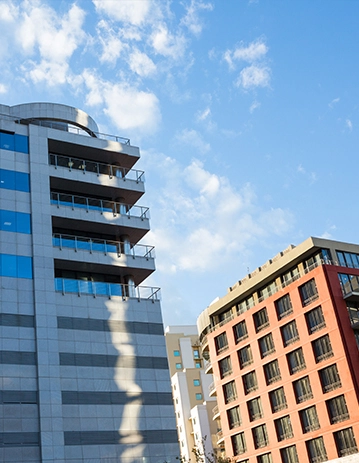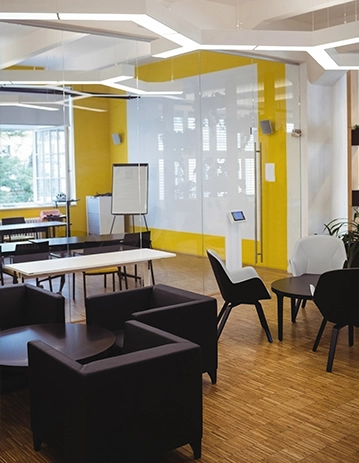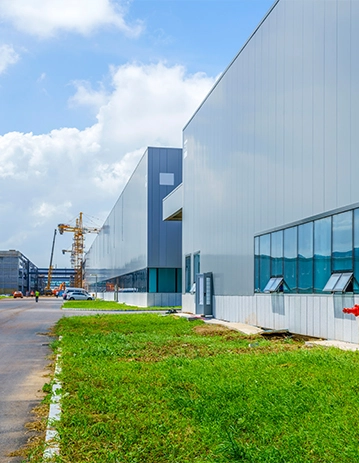Commercial Property Loans
Commercial Property is a different asset class from Residential Property. Generally speaking, the properties are more specialised, and have a much more restricted use case.
Commercial property is split further into a variety of sub-types |
Special Purpose
Special Purpose properties are designed for a specific use and their value is tied directly to their ability to perform that use. Examples of such properties include hotels/motels, childcare or healthcare facilities.
Mixed Use
Mixed Use properties include residential real estate that is designed and combined with commercial properties. These will generally combine office or retail locations together with residential dwellings.
Retail
Retail spaces comprise of single-tenant retail buildings, small neighborhood shopping centers, larger centers with grocery store anchor tenants, and “power centers” with large anchor stores. Retail spaces can range from small shops to large malls and are designed with the intent of attracting consumers. They are easily accessible to the public.
Office
Office properties are used for professional or business offices. These can be categorized into three sub-types: Class A (high-end, “trophy” buildings with the best amenities and infrastructure), Class B (average or above-average buildings without the special features of Class A), and Class C (older buildings needing maintenance and located in less desirable areas). Office buildings can be single-tenanted or multi-tenanted, and they can range from small professional buildings to towering skyscrapers.
Industrial
Industrial spaces are utilized for the purposes of production, manufacturing, warehousing and distribution of goods. This category includes warehouses, distribution centers, manufacturing buildings, and multi-use buildings that combine industrial with office space. They are generally located outside of urban areas, especially along major transportation routes. Some of the prominent industrial areas in Perth are Welshpool, Kewdale, Forrestdale, Malaga, Osborne Park, Wangara Kenwick, and Neerabup.
Commercial property is split further into a variety of sub-types
Industrial
Industrial spaces are utilized for the purposes of production, manufacturing, warehousing and distribution of goods. This category includes warehouses, distribution centers, manufacturing buildings, and multi-use buildings that combine industrial with office space. They are generally located outside of urban areas, especially along major transportation routes. Some of the prominent industrial areas in Perth are Welshpool, Kewdale, Forrestdale, Malaga, Osborne Park, Wangara Kenwick, and Neerabup.
Industrial
Read More
Office
Office properties are used for professional or business offices. These can be categorized into three sub-types: Class A (high-end, “trophy” buildings with the best amenities and infrastructure), Class B (average or above-average buildings without the special features of Class A), and Class C (older buildings needing maintenance and located in less desirable areas). Office buildings can be single-tenanted or multi-tenanted, and they can range from small professional buildings to towering skyscrapers.
Office
Read More
Retail
Retail spaces comprise of single-tenant retail buildings, small neighborhood shopping centers, larger centers with grocery store anchor tenants, and "power centers" with large anchor stores. Retail spaces can range from small shops to large malls and are designed with the intent of attracting consumers. They are easily accessible to the public.
Retail
Read More
Mixed Use
Mixed Use properties include residential real estate that is designed and combined with commercial properties. These will generally combine office or retail locations together with residential dwellings.
Mixed Use
Read More
Special Purpose
Special Purpose properties are designed for a specific use and their value is tied directly to their ability to perform that use. Examples of such properties include hotels/motels, childcare or healthcare facilities.
Special Purpose
Read More
Owner Occupation versus Investment |
When a property is owner-occupied, it is used for the business’s own purposes. When it is an investment property, it is leased out to a third party. What should you focus on when it comes to each of these aspects?
Owner Occupation
Location
The property's location should be conducive to your business operations, accessible to customers, employees, and suppliers. Consider factors like visibility, traffic patterns, and proximity to amenities.
Condition and Maintenance
Regular maintenance and repairs are essential to keep the property in good condition and prevent costly problems down the line. This includes both the interior and exterior of the building, as well as any landscaping.
Financing and Costs
Understand all the costs involved, including mortgage payments, property taxes, insurance, and maintenance. Secure financing that aligns with your business's financial capacity and long-term goals. This should be compared with the cost of leasing a similar property.
Legal and Regulatory Compliance
Ensure that your property complies with all local, state, and federal regulations, including building codes, safety standards, and accessibility requirements. Review these requirements regularly, as they can change.
Business Growth and Scalability
Consider how the property will accommodate your business as it grows. This might involve the potential for expansion, the ability to reconfigure space, or even the option to sublet if necessary.
Safety and Security
Implement security measures to protect your property and those who use it. This includes physical security measures like locks and alarm systems, as well as cybersecurity measures if your business involves sensitive data. Security also extends to having security of tenure. Ownership ensures that a landlord cannot kick you out.
Environmental Sustainability
Implementing sustainable practices can reduce your operating costs and improve your business’s public image. Consider energy-efficient upgrades, sustainable waste management practices, and green building certifications.
Exit Strategy
Have a clear plan for the future, whether that means selling the property, passing it on to a successor, or leasing it out. Understand the implications of these decisions for your business and your personal financial situation.
Investment
Location
The location is one of the most critical factors. Properties in high-demand areas, close to amenities, transport links, or in the path of future development, tend to appreciate more. The location also impacts the type of tenants you attract and your vacancy rates.
Property Type
Different types of properties - retail, office, industrial, multi-family, and special purpose - have different risks and returns. Consider your expertise, the demand and supply dynamics of the type, and future trends.
Tenant Quality
Look for properties with high-quality tenants with long-term leases. Creditworthy tenants can provide stable income streams. Evaluate the tenant mix in multi-tenant properties; a good mix can reduce financial risk.
Market Conditions and Trends
Understanding the current market conditions and future trends is crucial. This includes factors like employment rates, the local economy's health, and future developments in the area.
Property Condition and Age
Assess the condition and age of the property. Older properties might require more maintenance and upgrades. Ensure a professional inspection to uncover any potential issues.
Financial Performance
Review the property's financial performance (rental income and expenses). Consider the capitalization rate (cap rate), which helps evaluate the property's profitability.
Financing Options
Understand the financing options available to you and the costs associated with them. This includes the interest rates, loan terms, and any prepayment penalties.
Legal and Tax Considerations
Be aware of zoning laws, property taxes, and any legal issues tied to the property. Also, understand how owning a commercial property will impact your taxes.
Exit Strategy
Have a clear idea of your long-term strategy for the property. Whether it's selling after a certain period, refinancing, or holding the property to collect rent, your strategy should align with your overall investment goals.
Risk Factors
Consider the risks associated with the property and market, such as economic downturns, rising interest rates, or changes in market demand. Assess how these risks might impact your investment.
Location
The property's location should be conducive to your business operations, accessible to customers, employees, and suppliers. Consider factors like visibility, traffic patterns, and proximity to amenities.
Condition and Maintenance
Regular maintenance and repairs are essential to keep the property in good condition and prevent costly problems down the line. This includes both the interior and exterior of the building, as well as any landscaping.
Financing and Costs
Understand all the costs involved, including mortgage payments, property taxes, insurance, and maintenance. Secure financing that aligns with your business's financial capacity and long-term goals. This should be compared with the cost of leasing a similar property.
Legal and Regulatory Compliance
Ensure that your property complies with all local, state, and federal regulations, including building codes, safety standards, and accessibility requirements. Review these requirements regularly, as they can change.
Business Growth and Scalability
Consider how the property will accommodate your business as it grows. This might involve the potential for expansion, the ability to reconfigure space, or even the option to sublet if necessary.
Security and Safety
Implement security measures to protect your property and those who use it. This includes physical security measures like locks and alarm systems, as well as cybersecurity measures if your business involves sensitive data. Security also extends to having security of tenure. Ownership ensures that a landlord cannot kick you out.
Environmental Sustainability
Implementing sustainable practices can reduce your operating costs and improve your business’s public image. Consider energy-efficient upgrades, sustainable waste management practices, and green building certifications.
Exit Strategy
Have a clear plan for the future, whether that means selling the property, passing it on to a successor, or leasing it out. Understand the implications of these decisions for your business and your personal financial situation.
Investment
Location
The location is one of the most critical factors. Properties in high-demand areas, close to amenities, transport links, or in the path of future development, tend to appreciate more. The location also impacts the type of tenants you attract and your vacancy rates.
Property Type
Different types of properties - retail, office, industrial, multi-family, and special purpose - have different risks and returns. Consider your expertise, the demand and supply dynamics of the type, and future trends.
Tenant Quality
Look for properties with high-quality tenants with long-term leases. Creditworthy tenants can provide stable income streams. Evaluate the tenant mix in multi-tenant properties; a good mix can reduce financial risk.
Market Conditions and Trends
Understanding the current market conditions and future trends is crucial. This includes factors like employment rates, the local economy's health, and future developments in the area.
Property Condition and Age
Assess the condition and age of the property. Older properties might require more maintenance and upgrades. Ensure a professional inspection to uncover any potential issues.
Financial Performance
Review the property's financial statements, including income, expenses, and net operating income (NOI). Consider the capitalization rate (cap rate), which helps evaluate the property's profitability.
Financing Options
Understand the financing options available to you and the costs associated with them. This includes the interest rates, loan terms, and any prepayment penalties.
Legal and Tax Considerations
Be aware of zoning laws, property taxes, and any legal issues tied to the property. Also, understand how owning a commercial property will impact your taxes.
Exit Strategy
Have a clear idea of your long-term strategy for the property. Whether it's selling after a certain period, refinancing, or holding the property to collect rent, your strategy should align with your overall investment goals.
Risk Factors
Consider the risks associated with the property and market, such as economic downturns, rising interest rates, or changes in market demand. Assess how these risks might impact your investment.
Costs of Owning Commercial Property |
Upfront Costs

Purchase Price
The initial, most obvious cost. This can vary widely based on location, size, and type of property.

Due Diligence Costs
Fees for property inspections, environmental assessments, and appraisals to ensure the property is a good investment.

Closing Costs
Includes stamp duty, legal fees, title searches, title insurance, and lender fees, usually ranging from 5% to 7% of the purchase price.

Renovation or Repair Costs
Costs to prepare the property for tenants if it’s not move-in ready. This can include structural, aesthetic, or functional upgrades.

Deposit
If financing the property, expect to pay 20% to 30% of the purchase price upfront.

Building Insurance Premiums
Initial premiums for property insurance to cover potential damages.
Ongoing Costs

Property Management
Fees for property management services, if you choose not to manage the property yourself. Typically 5% to 10% of rental income. Note - Commercial management costs are often paid by the tenant.

Maintenance and Repairs
Regular maintenance costs to keep the property in good condition and emergency repair funds.

Utilities
Costs for electricity, water, gas, and other utilities, unless these are covered by the tenants.

Property Taxes
Annual taxes based on the property value, which can vary significantly by location.

Insurance Premiums
Ongoing property insurance and potentially other types of insurance like flood or earthquake.

Finance Payments
If you financed the property, monthly payments on the principal and interest.

Capital Expenditures (CapEx)
Large, infrequent expenses to maintain or improve the property value, such as replacing the roof or HVAC systems.

Vacancy Costs
Lost income from unoccupied spaces and marketing costs to attract new tenants.

Legal and Accounting Fees
Costs for professional services for lease negotiations, disputes, and financial record-keeping.
Remember, the exact costs can vary based on numerous factors, including the property’s location, type, condition, and market conditions. Always conduct thorough research and due diligence before purchasing commercial real estate.
How banks qualify a purchase of commercial property |
Investment Property

Loan-to-Value Ratio (LVR)
This is the loan amount divided by the property's appraised value or purchase price, whichever is lower. Banks typically prefer a lower LVR, often around 70-80% for commercial properties, as it indicates the borrower has a significant equity stake in the property.

Debt Service Coverage Ratio (DSCR)
This measures the property’s ability to cover its mortgage and interest payments. It's calculated by dividing the property's annual net operating income (NOI) by its annual total debt service. Banks usually look for a DSCR greater than 1.25x for commercial properties.

Credit History
The borrower's credit history is assessed to determine the likelihood of loan repayment.

Property Appraisal
Banks will conduct their own appraisal to determine the property's value and its capacity to generate income.

Lease Agreements
For investment properties, banks will review the lease agreements to understand the stability and duration of income.

Market Conditions
Economic and market conditions, including occupancy rates, demand for space, and local market rents, are considered.

Property Condition and Age
The condition and age of the property can affect its value and potential maintenance costs.

Environmental Assessments
This can include checks for contamination or other environmental hazards.
Owner-Occupied Property

Owner’s Equity Injection
For owner-occupied properties, banks often require a significant down payment or equity injection, typically around 20-30%.

Business Financials
The financial health of the business occupying the property is scrutinized, including cash flow, balance sheets, and profit and loss statements.

Business Plan
The lender may evaluate the business plan to understand the company's future growth prospects and how they align with the property being purchased.

Guarantor’s Creditworthiness
The personal financial statements and credit history of the business owners or guarantors are assessed.

Property Appraisal and Condition
Similar to investment properties, the appraisal, condition, and suitability of the property for the business are evaluated.

Debt Service Coverage Ratio (DSCR)
Even though this is an owner-occupied property, banks still assess the DSCR to ensure the business generates sufficient cash flow to cover the loan payments.

Industry Risk
Banks consider the risk associated with the borrower's industry, as some sectors may be considered more volatile or risky than others.

Legal and Regulatory Compliance
Ensuring that the property and business comply with relevant laws and regulations is crucial for the bank.






